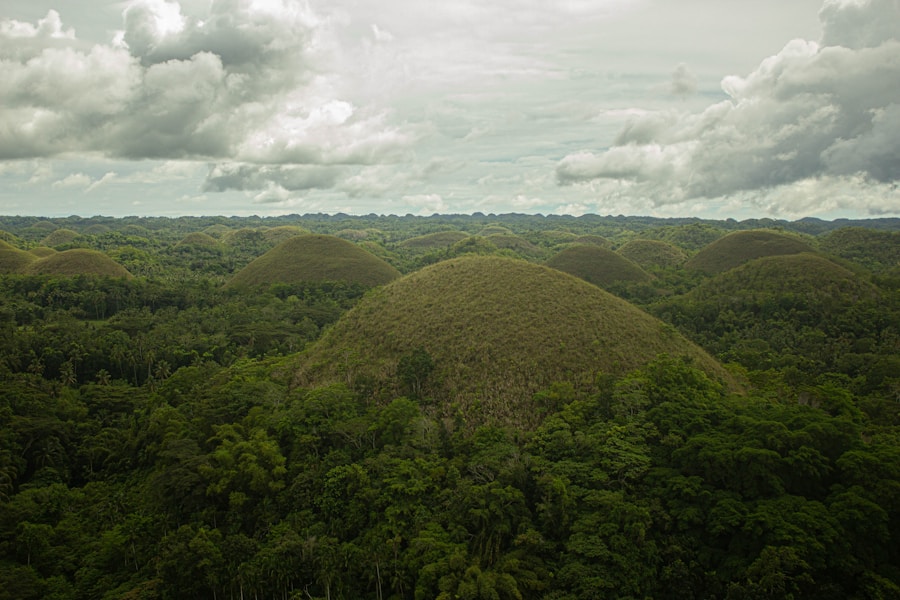Download links
How to install Exploring the Mysterious Chocolate Hills APK?
1. Tap the downloaded Exploring the Mysterious Chocolate Hills APK file.
2. Touch install.
3. Follow the steps on the screen.
Description
The Chocolate Hills, a geological wonder located in the Bohol province of the Philippines, have captivated visitors with their unique and striking appearance. These hills, numbering over 1,200, rise dramatically from the surrounding landscape, creating a surreal panorama that has sparked curiosity and intrigue for centuries. The origin of these hills is rooted in a combination of geological processes that date back millions of years.
The prevailing theory suggests that they were formed through the uplift of coral deposits and limestone, shaped by the forces of erosion and weathering over time. This process began during the Pleistocene epoch when the region was submerged under the sea, allowing marine organisms to deposit calcium carbonate, which eventually solidified into limestone. As tectonic activity raised the land above sea level, the limestone formations were exposed to the elements.
Rainwater, rich in carbonic acid, began to erode the limestone, creating a series of conical hills. The unique shape of the Chocolate Hills is attributed to this erosion process, which has sculpted the landscape into its current form. The hills are characterized by their symmetrical, cone-like shapes, which can reach heights of up to 120 meters.
The name “Chocolate Hills” comes from the brown hue that the grass covering the hills takes on during the dry season, resembling mounds of chocolate. This transformation adds to the allure of the hills, making them a popular destination for tourists seeking to experience their natural beauty.
Key Takeaways
- The Chocolate Hills in the Philippines are believed to have formed from the weathering of limestone over millions of years.
- The unique geological formation of the hills consists of around 1,268 cone-shaped hills spread over an area of 50 square kilometers.
- Local myths and legends surrounding the Chocolate Hills include stories of giants throwing rocks and tears of a grieving giant turning into the hills.
- The flora and fauna of the Chocolate Hills include various species of plants, birds, and butterflies, some of which are endemic to the area.
- The best ways to explore the Chocolate Hills include hiking, biking, or taking a guided tour to enjoy the breathtaking views and learn about the local culture and history.
- Conservation efforts to protect the Chocolate Hills include reforestation projects, waste management initiatives, and sustainable tourism practices to preserve the natural beauty and biodiversity of the area.
The Unique Geological Formation of the Hills
The geological formation of the Chocolate Hills is not only fascinating but also serves as a testament to the dynamic processes that shape our planet.
Over millions of years, these materials were compacted and cemented together, creating a solid foundation for the hills.
The unique topography of the region is a result of both chemical and physical weathering processes that have acted upon the limestone. One of the most intriguing aspects of the Chocolate Hills is their uniformity in shape and size. While there are variations among individual hills, they generally exhibit a similar conical form that sets them apart from other geological formations.
This uniformity can be attributed to the consistent erosion patterns that have affected the landscape over time. Rainfall plays a crucial role in this process; as water seeps into cracks in the limestone, it gradually dissolves the rock, leading to further erosion and shaping of the hills. The result is a landscape that appears almost otherworldly, with rolling hills that seem to stretch endlessly across the horizon.
The Local Myths and Legends Surrounding the Chocolate Hills

The Chocolate Hills are not only a geological marvel but also a source of rich folklore and mythology among the local communities. One popular legend tells the story of two giants who engaged in a fierce battle over a beautiful maiden. According to this tale, the giants hurled boulders at each other in their rage, creating massive craters in the landscape.
After their battle ended, they left behind the remnants of their conflict—the Chocolate Hills—forever marking their struggle in the earth. This story reflects the deep connection between the local people and their environment, as well as their attempts to explain natural phenomena through storytelling. Another legend speaks of a giant named Arogo who fell in love with a mortal woman named Aloya.
Their love was pure and passionate, but tragedy struck when Aloya passed away. Heartbroken, Arogo wept for days, and his tears formed the hills we see today. This poignant tale not only illustrates the emotional depth of local folklore but also serves as a reminder of how natural landscapes can be imbued with human experiences and emotions.
Such myths contribute to the cultural significance of the Chocolate Hills, making them more than just a tourist attraction; they are woven into the fabric of local identity and heritage.
The Flora and Fauna of the Chocolate Hills
| Category | Metrics |
|---|---|
| Flora | Over 1,200 plant species |
| Fauna | Various species of birds, mammals, and reptiles |
| Endemic Species | Several endemic species found only in the Chocolate Hills |
| Conservation | Protected area to preserve the unique biodiversity |
The biodiversity surrounding the Chocolate Hills is as remarkable as their geological features. The area is home to a variety of plant species that thrive in its unique environment. During the wet season, lush greenery blankets the hills, with grasses and shrubs flourishing in abundance.
However, as the dry season approaches, this vibrant landscape transforms into a golden-brown hue, giving rise to its chocolate-like appearance. The flora includes several endemic species that have adapted to the specific conditions of Bohol’s climate and soil composition. In addition to its diverse plant life, the region is also rich in fauna.
Various species of birds can be spotted soaring above the hills, including endemic species such as the Philippine tarsier and several types of raptors. The tarsier, one of the world’s smallest primates, is particularly notable for its large eyes and nocturnal habits. These creatures play an essential role in maintaining ecological balance within their habitat.
Other wildlife includes reptiles and insects that contribute to the overall biodiversity of the area. The presence of such varied flora and fauna highlights the ecological importance of preserving this unique landscape.
The Best Ways to Explore the Chocolate Hills
Exploring the Chocolate Hills offers visitors an opportunity to immerse themselves in one of nature’s most captivating landscapes. One popular way to experience this natural wonder is by hiking up to one of the viewing platforms strategically located on some of the higher hills. These platforms provide panoramic views that allow visitors to appreciate the sheer scale and beauty of the hills from above.
The trek can be invigorating, with well-maintained paths leading through lush vegetation and offering glimpses of local wildlife along the way.
Local guides often share stories about the myths surrounding the hills while pointing out unique features of the landscape.
Additionally, some tours include visits to nearby attractions such as rice paddies and traditional villages, allowing visitors to gain a deeper understanding of Bohol’s rich culture and history. For adventure enthusiasts, biking or ATV tours offer an exhilarating way to navigate through the rolling terrain while enjoying breathtaking views at every turn.
The Conservation Efforts to Protect the Chocolate Hills

Embracing Sustainable Tourism
Local government initiatives focus on sustainable tourism practices that aim to minimize human impact on this delicate ecosystem while still allowing visitors to enjoy its beauty. Educational programs have been implemented to raise awareness about environmental issues among both locals and tourists alike, emphasizing the importance of preserving natural resources.
Restoration and Reforestation Efforts
In addition to educational efforts, there are ongoing projects aimed at restoring native vegetation around the hills to combat soil erosion and promote biodiversity. Reforestation initiatives have been introduced to replant native trees and shrubs that can help stabilize soil and provide habitats for local wildlife.
A Brighter Future for the Chocolate Hills
These conservation measures not only protect the geological integrity of the Chocolate Hills but also enhance their ecological value by fostering a thriving environment for various species. Through these combined efforts, stakeholders hope to ensure that this iconic landscape remains a source of wonder and inspiration for generations to come.
FAQs
What are the Chocolate Hills?
The Chocolate Hills are a geological formation in the Bohol province of the Philippines. They are made up of around 1,268 cone-shaped hills, which are covered in green grass that turns brown during the dry season, giving them the appearance of chocolate kisses.
How were the Chocolate Hills formed?
The exact formation process of the Chocolate Hills is still a subject of debate among geologists. However, it is widely believed that they are the result of the uplift of coral deposits and the action of rainwater and erosion over millions of years.
What is the best time to visit the Chocolate Hills?
The best time to visit the Chocolate Hills is during the dry season, which typically runs from late November to May. This is when the grass covering the hills turns brown, giving them their chocolate-like appearance.
Are there any activities to do at the Chocolate Hills?
Visitors to the Chocolate Hills can enjoy activities such as hiking, bird watching, and taking in the panoramic views from the viewing deck. There are also ATV tours and zip-lining available for those seeking a more adventurous experience.
Is there an entrance fee to visit the Chocolate Hills?
Yes, there is an entrance fee to visit the Chocolate Hills. The fee helps with the maintenance and preservation of the area.





